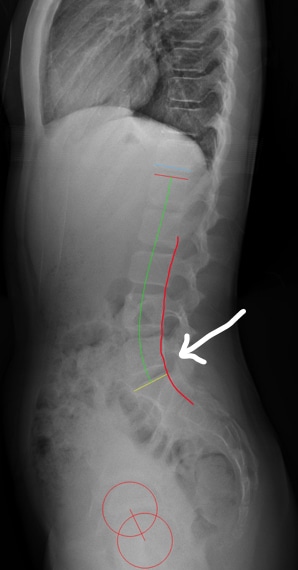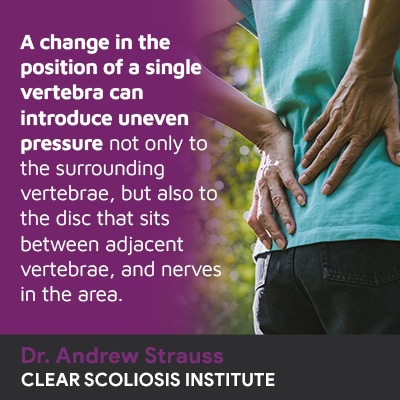
The spine helps us to stand upright, practice healthy posture, bend, lift, twist, and the spinal cord partners with the brain to form the central nervous system (CNS). If the spine’s vertebrae are aligned as they should be, its healthy curves are in place, but if a condition like spondylolisthesis develops, the position of a vertebra is disrupted, making it difficult for the spine to maintain its natural curves and alignment.
Spondylolisthesis is a spinal condition involving instability. While the spine’s design is movement-based, if a vertebral body moves excessively, it can slip out of alignment with the rest of the spine, losing its correct position in relation to the vertebra below, which can cause a number of issues.
Before exploring the nature of spondylolisthesis, let’s take a look at the anatomy of a healthy spine.
As mentioned, the spine plays many important roles in maintaining health and wellness, and as such a key structure, it is also vulnerable to a number of conditions, many of which involve a loss of its healthy alignment and/or curves.
If the spine is aligned as it should be, the vertebrae (bones of the spine) are stacked on top of one another in correct alignment.
A healthy spine will appear straight when viewed from the front and/or back, but is curved like an ‘S’ when viewed from either side.
The spine’s healthy curves and alignment are key parts of its design, and without them, it can’t function optimally.
A healthy spine combines the strength of a column with the flexibility of a spring: a masterpiece of engineering!
The spine is curved at each of its three main sections: cervical spine (neck), thoracic spine (middle/upper back), and the lumbar spine (lower back).
The spine’s healthy and natural curves are key to spinal alignment and make it stronger, more flexible, and facilitate its ability to absorb and distribute mechanical stress; this helps avoid uneven wear and tear on the spine.
Conditions that introduce uneven wear and pressure to the spine and its individual parts can cause a number of issues.
As spondylolisthesis develops, it makes the spine unstable, and this impacts its ability to function as it was designed.
While the vertebrae, and the intervertebral disc in between, work together to facilitate flexible movement, if a vertebra is moving beyond a normal range, it can cause it to shift out of alignment with the rest of the spine; spondylolisthesis is when this shifting allows the affected vertebra to shift onto the vertebral body below.
A change in the position of a single vertebra can introduce uneven pressure not only to the surrounding vertebrae, but also to the disc that sits between adjacent vertebrae, and nerves in the area.
The spine is home to 31 pairs of nerves that facilitate brain-body communication as part of the central nervous system, and that’s why spinal conditions can cause such a wide range of symptoms felt throughout the body.
So what are the symptoms of spondylolisthesis?
As is the case with many spinal conditions, spondylolisthesis can cause a wide range of symptoms ranging from mild to severe.
Some patients will experience several different symptoms, while others might not experience any symptoms at all.
There are many factors that shape a person’s experience of life with the condition such as patient age, underlying cause, and condition severity, but some common symptoms include:

While spondylolisthesis can develop in other spinal sections, it most often involves a vertebra in the lumbar spine; this is because the vertebrae of the lumbar spine have to support the weight of the trunk, the spinal sections above, and feel the effects of bending, lifting, and twisting motions.
There are also different degrees of slippage, with high-grade slippage occurring when 50 percent or more of the affected vertebra slips forward onto the one below, and the higher the grade of slippage, the more likely it is to cause noticeable symptoms.
Sciatic nerve pain is a common symptom of lumbar spondylolisthesis because the sciatic nerve starts in the lumbar spine, so if a vertebra’s shift is compressing (excessive pressure) the sciatic nerve, sciatica can develop as a related symptom/complication.
There are many different causes of spondylolisthesis, and when it comes to treatment efficacy, the condition’s underlying cause has to shape the design and customization of treatment plans.
Spondylolisthesis has many different causes, which is why part of diagnosing a condition involves further classifying it as one of 6 types.
Spondylolysis can be classified as congenital, meaning people are born with the condition due to abnormal development of a vertebral body, in particular, the part that regulates movement.
Isthmic spondylolisthesis is the most prevalent type and is caused by damage to a vertebra commonly caused by trauma, overuse, hyperextension, or injury that fractures the pars interarticularis: a thin bone that connects the back of the vertebrae (the bump you feel on your back) with the front, or body, of the vertebrae (the part with the disc)
Spondylolisthesis can also be caused by age-related spinal degeneration that most often affects the intervertebral disc between adjacent vertebrae. Due to slackness in the ligaments supporting the spinal bones, slippage can occur.
Fractures within the facet joints that connect the vertebrae can also cause the development of spondylolisthesis.
Very rarely, the presence of tumors pressing on the vertebrae can also lead to fractures, slippage, and spinal instability.
Iatrogenic spondylolisthesis involves a weakened spine caused by surgery.
So spondylolisthesis has a number of causes from a malformed vertebra that develops in utero, fractures, defective pars, age-related spinal degeneration, tumors, overuse injuries, and spinal instability caused by spinal surgery.
Now that we’ve defined the condition, explored some common symptoms and causes, let’s talk about treatment options.
There are two main treatment approaches, known as traditional and conservative; traditional treatment focuses on symptom management with the prescription of pain medications, steroid injections, and surgery, while conservative treatment offers a non-surgical treatment option that’s less invasive and focuses on maintaining as much of the spine’s natural function/strength as possible.
Conservative treatment focuses on the underlying cause of symptoms, like pain and inflammation, by treating the condition itself, and this is shaped around the condition’s type, determined by its cause.
Relieving symptoms of spondylolisthesis in a way that’s sustainable and long term can be worked towards by addressing their underlying cause, which is the spinal instability and misaligned vertebrae.
As a CLEAR-certified scoliosis chiropractor, I want to be proactive with all spinal conditions I treat, and this is because if left untreated, or not treated proactively, more degeneration may occur, making conditions more complex to treat, and potentially leading to the development of other related spinal conditions.
Although I can never give treatment guarantees, through condition-specific chiropractic care, it can be worked towards that the position of a vertebra that’s slipped forward onto the bone below is adjusted so it’s more aligned with the rest of the spine, taking pressure off the lower vertebral body and surrounding nerves.
Addressing areas of vertebral subluxation with a series of chiropractic techniques (traction/flexion-distraction therapy) and manual adjustments can improve related symptoms because their underlying cause is being addressed and improved: the misaligned spine.
Strengthening the spine’s surrounding muscles is a key facet of treatment because a spine that’s surrounded by strong muscles is a spine that’s receiving optimal support and stabilization, taking pressure off the spine and its individual structures and nerves.
Custom designed spondylolisthesis specific exercises and therapies are the key to increasing core strength, aligning the spine, and educating the patient on how to avoid aggravating the spinal instability. A specialized form of customized bracing can be another component of proactive treatment that can help stabilize an unstable spine.
The spine’s design is based on movement, but when there is too much movement, a vertebra’s position can change; in certain cases, this can cause it to shift forward and onto the vertebra below, causing uneven pressure on the area and a misaligned spine.
The uneven pressure caused by the vertebra’s change in position can be felt at the level of the vertebra itself, the vertebra below, the disc that sits between adjacent vertebrae, and surrounding spinal nerves in the area.
As a condition of spinal instability, if left untreated, it can cause excessive spinal degeneration that can get progressively worse over time, and particularly with age; that level of increasing spinal instability can contribute to the development of a number of other spinal conditions.
Addressing a condition’s underlying cause means not just treating its symptoms, but the cause of the symptoms for long-term sustainable results, especially when it comes to pain management.
Spondylolisthesis has a number of causes from a birth defect to spinal injury, fractures, trauma, age-related spinal degeneration, tumor(s) pressing on the spine, and/or spinal instability caused by surgery.
My proactive approach to treating spondylolisthesis involves first determining a condition’s underlying cause and shaping a customized treatment plan around it; this can help minimize the condition’s effects, prevent further spinal deterioration, and preserve the spine’s natural strength and function.

CLEAR provides a unique and innovative way of understanding scoliosis. Sign up to receive facts and information you won’t find anywhere else.
